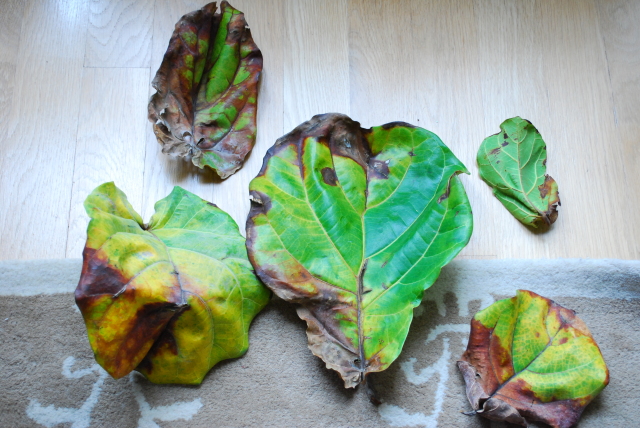Question
 Ficus Lyrata Dropped L
Ficus Lyrata Dropped L
Dear Will,
As probably you have been asked hundreds of times, why is my dear Ficus Lyrata dropping its leaves?
We purchased this tree exactly on May 3rd, 2011 in the plant district of NYC and placed it on doubled wide south facing window with 2 backyards of space between the next building. Its leaves were all beautifully medium dark green when we brought it home and have been watering more or less once a week or until the soil is dry at the touch of the first 1 or 2 inches of depth. I also fertilized with 8-7-6 all purpose food plan after two weeks of being at home.
Over the two weeks or so, my dear plant has been dropping about 12 leaves from the middle-bottom to the bottom. The leaves that drop have been greenish with yellow and brown spots. Also some leaves that are from the middle to the bottom have a white powdery film mainly toward the center and near the stem. And finally the most worrying issue, I found what I believe are mealybugs under one leaf stem and another over a leaf with cottony spider web like. Last week, I sprayed this tiny white fury dots with Concern insect killing soap.
In the last 4 days the tree has lost about 5 more leaves and I am starting to feel frustrated by my lack of success and of correct diagnosing with my tree. I have relatively little experience with plants and their diseases and problems. I have been planting indoor seasonal plants for only a few years and my only success has been a ponytail palm that I know I would have to have a pretty darn "black tumb" to kill it.
I created a photo gallery of several images that illustrate all the issues mentioned. The gallery is located at mac gallery and can be seen on the following link. http://gallery.me.com/vanessa.chapeton#100144
Waiting anxiously for your esteemed response and advice.
Thank you in advance.
Sleepless in NY,
Vanessa Chapeton
AnswerHi Vanessa,
Thanks for the many photos. They are quite helpful. Yes, I have been asked this question many times, but the answer is not always the same. That's because the discoloration of the leaves doesn't reveal much because that discoloration and leaf drop are how Lyratas respond when they are under stress for any reason.
It looks like the light you are providing is pretty good. I am assuming there is no tall building across the backyards that blocks the sun and that you have the window uncovered during the day. If so, then we can rule out available light as a problem.
That said, in the photos I see very dense leaf growth, meaning that the leaves are very close together with little stem space between the leaves with many leaves massed together in the center of the tree. That tells me that your Lyrata was grown in very strong light and not acclimated very well to indoor light, which is much less intense than outdoor shade. So even though you are providing good light, your Lyrata still must adapt to the reduced light. It does that by shedding older leaves that are near the bottom and in the center. Both of those locations are shaded by the other leaves and therefore get relatively less light.
Unfortunately, there is not much you can do about this acclimatization process as the plant adapts to the light in your home. The leaf drop will continue as healthy new growth is added at the ends of stems. Eventually, you will have a Lyrata that will be healthy, but will have a more spare appearance with longer spaces between the leaves and not very many leaves in the center of the tree. It will look different, but it will be healthy and can still be attractive.
The powdery film appears to be residue from insecticidal sprays used in the nursery. Some firm rubbing with soap and water should remove it. I don't see any evidence of spider mites and Lyratas are not a favored host of spider mites anyway. It does look like there may be a mealybug in one of the photos. Typically, they do tend to congregate in tight spaces where they are less noticeable. If you remove the dry brown sheaths where the leaves attach to the stems, you will be better able to see into potential hiding spaces.
Your soap spray will be more effective if you add rubbing alcohol to it in a ratio of 5 parts Concern to one part alcohol. Be sure to spray very thoroughly in the crevices where the mealybugs like to hide. I can't tell from the photos if the raised bumps are scale insects or just part of the stems. To be on the safe side, be sure to spray all of them also.
If you continue to water as you have described and provide as much light as possible and treat the mealybugs as I have described, I think your Lyrata will be fine. However, you do have to expect that leaf loss will continue, but also remember that healthy new leaf growth will slowly emerge and alter the overall appearance of your Lyrata.
With that knowledge, I hope your anxiety level has declined!
Please let me know if any of this is unclear or if you have any additional questions. I do make plant housecalls in Manhattan.
If this information has been helpful, please click the Rate Volunteer bar below and enter a rating and nomination for me. I am a volunteer on this site so Ratings are the only compensation I receive for answering plant questions.
Need more information? Visit my website at www.HorticulturalHelp.com
or email me at
[email protected] or call me at 917-887-8601 (EST)
Regards,
Will Creed, Interior Landscaper
Horticultural Help, NYC
Visit my website at www.HorticulturalHelp.com






